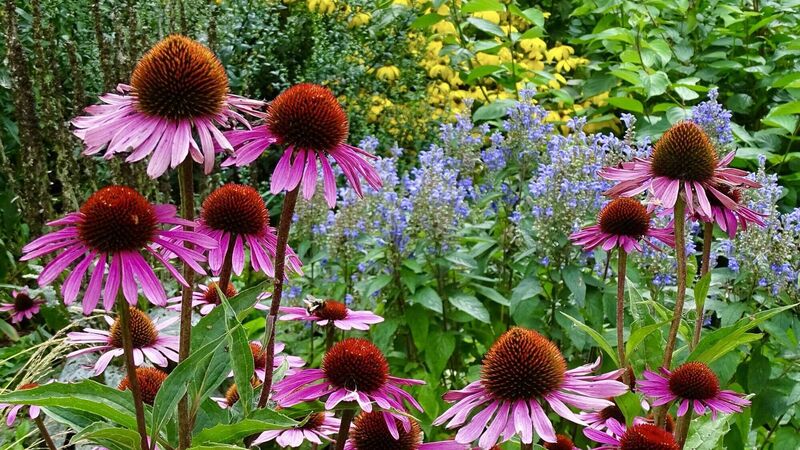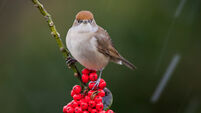The blooming best flowers for autumn months

At its best during August and September, echinacea brings a vibrant colour splash to the garden and is loved by bees and butterflies. Picture: iStock
August is that time in the garden when many perennials are still giving of their best and filling the garden with colour, though the rest of the garden may be slowing down before autumn arrives.
Here’s a look at some of the best performing plants for August in the garden.
Russian sage, correctly referred to as Perovskia atriplicifolia is one of those plants that may not demand much attention for much of the year, indeed during winter and early spring it can look a bit bedraggled, like myself, but during late summer and into autumn it is a real showstopper with tall blue flowers on silvery green stems. The effect of a plant in full bloom or a mass planting can be a haze of silvery blue on a sunny day.
Requiring well-drained soil in full sun, the variety blue spire will reach a height of 1.2m and while it will tolerate an exposed position you might be better to opt for the lower-growing variety little spire, which only reaches about 60cm, if your garden is windy as the taller stems can often end up growing along the ground in windy spots.
Caryopteris is another blue-flowering plant, a deciduous shrub which will mature to about 1m high and 1m wide. Masses of inky blue flowers are produced from July onwards and survive well into September and beyond.
CLIMATE & SUSTAINABILITY HUB
Absolutely loved by bees and butterflies, caryopteris is perfect in a sunny spot in amongst other blues or whites.
Echinacea, often known more in tablet form as a health supplement than as a plant is a really spectacular performer during
August. Another one which likes full sun and well-drained soil. Give it these two conditions and you will have a trouble free, summer and autumn performer each year. The species, Echinacea purpurea or coneflower will grow to about 1m in height and produces beautiful pink blooms with slightly reflexed petals around an orange/brown centre.
Cut back dead flower stems to promote blooms but do leave the last ones on the plant as they not only create a lovely winter look but their seed heads also provide food for smaller birds during the winter.
There are too many cultivars of echinacea now to count and they come in different heights, shades of pink and now also orange, white and red. Like all herbaceous perennials, you can cut echinacea back to ground level in early spring. Verbena bonariensis is a short-lived perennial meaning that when you plant one, I wouldn’t expect it to still
be there in five or six years though it will have set seed freely, meaning that you should have plenty of seedlings available in the garden to take its place.
The species will grow nearly as tall as two metres but lower forms such as lollipop will remain much smaller as will the deeper purple, Verbena rigida. The tall-growing V bonariensis, for me, is a plant best used with others. Mix it with a tall ornamental grass such as a molinia or calamagrostis for best effect or if you are getting adventurous with your colour you could try it with an orange helenium or crocosmia as the contrast can be striking and vibrant.
Stipa Ponytails is a semi-evergreen ornamental grass and thus, looks wonderful all year round, its airy texture, bringing constant lightness and movement to the garden. However, it is during the late summer and autumn days of August and September when it is at its best. The flowers are just turning to seed heads and the beautiful, fresh lime-green colour, changes now to a more seasonal, autumnal, oat colour. It is at its biggest and airiest best right now, swaying in the summer breeze offering its seeds to the passing wind and animals. Plant it anywhere in the garden where you need some lighthearted breezy movement.
For so many years the staple of August in Irish gardens dahlias are resurging in popularity.
There are so many flower types that there is bound to be one that you will fall for. The perfect pompoms and cactus forms along with the ornamental forms which produce blooms the size of dinner plates may all be a bit too perfect and dare I say it, garish for your taste.
Much simpler flower forms and suited to the trend of naturalistic-style planting, these beauties come in reds, yellows, pinks, oranges and white. Dahlias also like well-drained soil. I recommend horticultural grit around the tuber when planting, to ensure the tubers aren’t in wet soil, important if you leave the tubers in the ground over the winter. These single-form dahlias are again loved by bees and other pollinating insects.

Unlimited access. Half the price.
Try unlimited access from only €1.50 a week
Already a subscriber? Sign in
CONNECT WITH US TODAY
Be the first to know the latest news and updates












